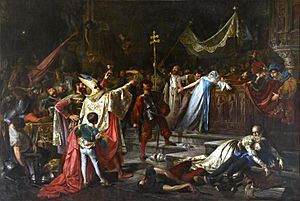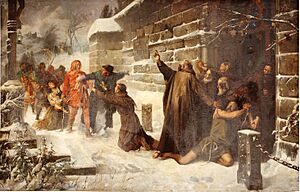Francisco Javier Amérigo facts for kids

Francisco Javier Amérigo y Aparici (born June 2, 1842, in Valencia; died March 28, 1912, in Madrid) was a Spanish painter. He was well-known for his detailed paintings of historical events.
Contents
About Francisco Amérigo
Early Life and Art Training
Francisco Amérigo started his art studies at the Real Academia de Bellas Artes de San Carlos in Valencia. His main teacher there was Francisco Martínez Yago. Interestingly, Martínez Yago's son, Salvador Martínez Cubells, later became Francisco's best friend. In 1860, while still a student, Francisco won a medal at an art show in Alicante. After his time in Valencia, he continued his studies at the Real Academia de Bellas Artes de San Fernando in Madrid.
Studying and Painting in Rome
In 1865, Francisco traveled to Rome, Italy, to continue his art education. There, he met other important painters like Eduardo Rosales and Mariano Fortuny. Their painting styles had a big influence on his own work.
While in Rome, in 1876, he sent his painting Good Friday at the Colosseum in Rome to the National Exhibition of Fine Arts in Spain. This was a very important art competition. His painting won a Second Prize.
Famous Historical Paintings
The next year, Francisco returned to Spain. He presented another major work called The Sack of Rome. This painting was a huge success and won a First Prize at the National Exhibition. He dedicated this painting to his friend, Víctor Balaguer, who was a politician and writer. Balaguer later added the painting to his personal collection, which eventually became the Biblioteca Museo Víctor Balaguer, a museum and library.
In 1892, Francisco Amérigo won another First Prize at the National Exhibition for his painting The Right of Asylum.
Besides his famous historical paintings, Francisco also created religious artworks. One notable example is the ceiling he painted at the Royal Basilica of San Francisco el Grande in Madrid. He also used his artistic skills to design backgrounds and sets for plays at the Teatro Martín in Madrid.
See also
 In Spanish: Francisco Javier Amérigo para niños
In Spanish: Francisco Javier Amérigo para niños


